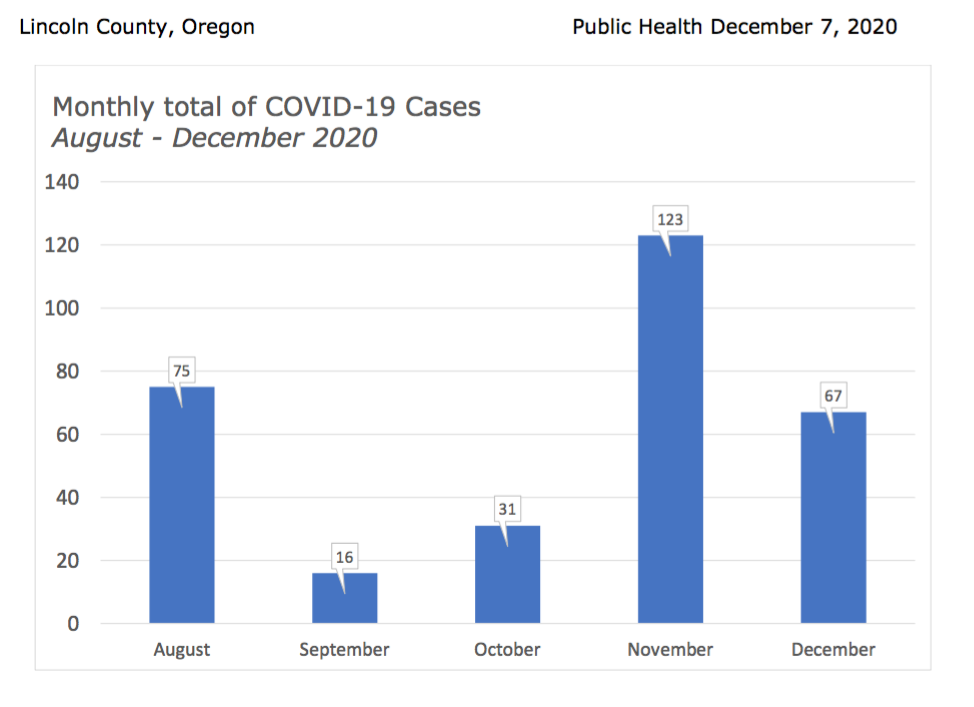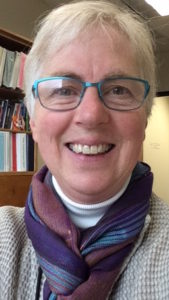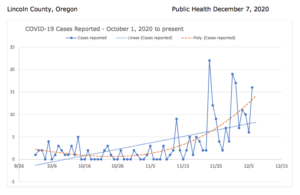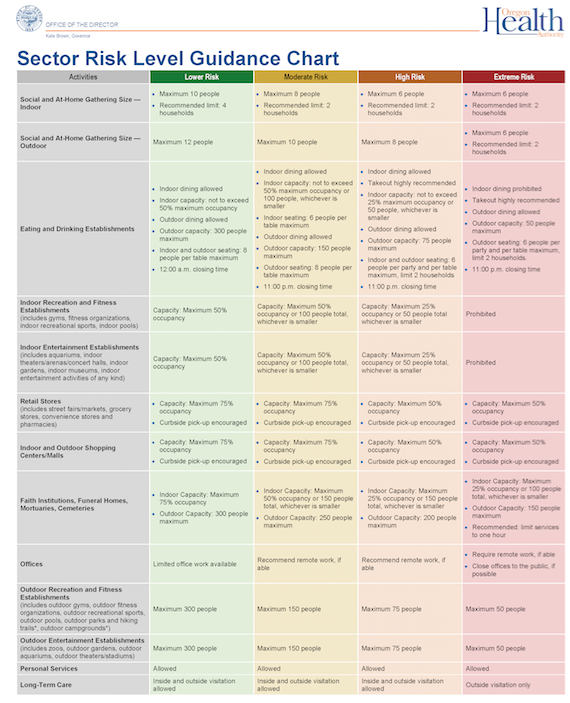
By QUINTON SMITH/YachatsNews.com
The number of coronavirus cases in Lincoln County have grown so numerous – 94 in the last seven days – that the county will likely move into the state’s “extreme risk” category Dec. 18.
That means indoor dining at restaurants and bars will shut down again, offices workers would be required to work remotely if they can, gyms would close, and indoor entertainment like aquariums and theaters would have to close through New Year’s Eve, Dec. 31.
It also led the Lincoln County School District on Tuesday to announce it would return all grades to online instruction when school resumes Jan. 4 from its winter break.
The Oregon Health Authority on Tuesday sent a warning letter to the county saying its COVID-19 cases had grown so high that without some sort of drastic drop, the new, tighter restrictions would take effect Thursday, Dec. 18. Lincoln County is one of five counties in the state’s “high” risk category; 25 counties are “extreme.”
Even though the number of COVID-19 cases in Oregon and across the nation have been setting records, state and local health officials are now seeing the anticipated spike from social gatherings during the Thanksgiving holiday.
Lincoln County has seen double-digit case numbers for most of the past week and 127 cases in the last 11 days, Lincoln County Public Health said Wednesday. In addition, there have been six people hospitalized so far this week, a serious trend given the small number of beds in the county’s two hospitals and the fact that just 28 people had been hospitalized for COVID-19 all year.
County health officials say the big increases are a second surge of cases connected to Thanksgiving gatherings now showing up 10 days after the holiday.

“We’re definitely headed to the ‘extreme risk’ category,” Public Health Director Rebecca Austen told county commissioners Monday. “… and we’re just now starting to see the results from Thanksgiving.”
Counties move up or down the state’s four categories – low, moderate, high and extreme – based on the number of COVID-19 cases per 100,000 population.
The first two weeks of November, Lincoln County’s rate was 44 per 100,000 – putting it in the “moderate” category, if the restrictions had been in place then. But by the time they went into effect Dec. 3, the county’s case rate was 161 per 100,000 — putting it in the “high” risk category, which carries tighter restrictions on business and social activities.
Based on the last two weeks, Austen said Monday, the county’s rate is now 281 per 100,000 people – pushing it above the 200 case per 100,000 threshold for the “extreme” category.

If that’s still the case on Monday, when the next measurement is taken, that means indoor and outdoor social and at-home gatherings would be limited to six people with a recommended limit of two households, restaurants once again could only offer outdoor dining and takeout food. Retail stores would keep a 50 percent capacity limit, as would outdoor shopping malls. Churches and funeral homes would maintain a 25 percent capacity limit.
Under the state’s new four-stage restrictions, the OHA examines and publishes county data weekly and risk levels are reassigned every two weeks. But the OHA will give counties a “warning week” to prepare for changes – with the first change under the new metric coming Thursday, Dec. 18.
While Austen told commissioners that there is good news in that there are currently no COVID-19 hospitalizations, the bad news is that clusters of outbreaks – 28 as of Monday – are “from all over the place.” On Wednesday, the OHA announced a workplace outbreak of eight cases at the Lincoln City Safeway store.
“We can probably get the award for going into 2021 with the worst foot forward,” Austen said.
Can or should Lincoln County do more to contain the outbreak locally, asked Commissioner Claire Hall, an apparent reference to the county closing lodging last March when the pandemic first hit Oregon, or doing more to police large social gatherings.
Austen advocated continuing the county’s public education campaign. County Counsel Wayne Belmont said the state’s new four-step framework is intended to be Oregon’s answer to that until vaccines begin appearing.
“The real question is … does this framework actually slow the surge. Is it effective?” Belmont said. “We need to give it an opportunity to work.”
School district announcement
Because of the surge in cases, the Lincoln County School District said Tuesday it would end “hybrid” instruction for kindergartens through third-graders after the Christmas and New Year’s break and return all students to online classes Jan. 4.
In an email to parents and the community, Superintendent Karen Gray said if cases don’t spike too much the district should be able to continue in-class instruction for the four grades until winter break begins Dec. 19.
Gray said the change is being forced because the spike in cases put the district in a “red” zone, under which state requires it to go to online instruction only.
She said the district still hopes to begin hybrid classes – two days a week in class and two days online – for all grades on Feb. 1.
On Tuesday night, Gray reminded the school board that in early November the district was one of the few in Oregon whose case count was low enough to bring all students back to school two days a week. Instead, administrators chose to try to bring students back in clusters of grades over five weeks — which was foiled when COVID-19 cases began spiking.
That has changed even more with the growing COVID-19 cases from Thanksgiving, Gray said, and will likely get worse after an even bigger surge from the Christmas and New Years holidays.
“It will probably be that way for the entire month of January,” Gray said. “We’ll see another surge mid-January and then I think it will calm down.”
But she termed “heart breaking” the decision to send the district’s youngest students back home for online instruction in January.
“We’ve been successful K-3,” she said. “To turn around now and send those kids home is heartbreaking. But if the numbers don’t go down we can’t go back to school.”




Any sort of share the air situation such as bars and restaurants where people sit in the same room unmasked is a virus infection risk especially since our state is not even testing the many asymptomatic spreaders who are not being identified at all. Why wait even 8 days to curtail that? There are still many people traveling around from more infected states and larger cities in Oregon around our area, and while that might be good for business, it is potentially bad for the health and safety of many who live here.